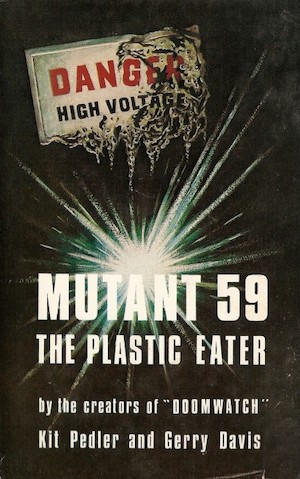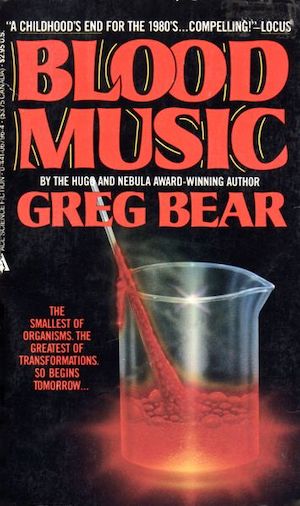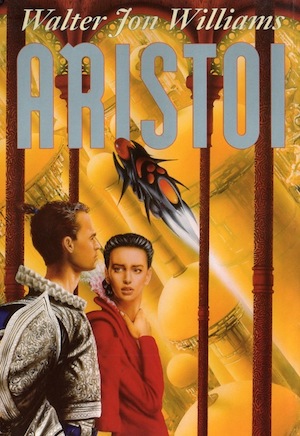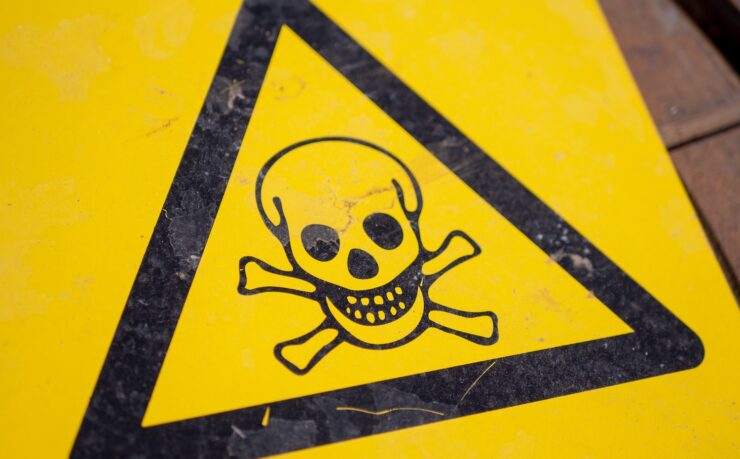Is it possible that our modern preoccupation with safety has stripped much of the fun from modern life? Children are no longer permitted to ride automobile running boards until they are flung off, home chemistry sets omit the more interesting lanthanides, and it’s a rare grade-schooler who gets to play with dynamite these days…
Worse yet, this collective embrace of a more sensible, risk-averse approach to life could even be impeding technological progress. It’s no surprise, therefore, that some visionary SF writers have had their protagonists give the one-fingered Mudra of Contempt to putting regulation before pursuing progress at any cost. Such ambition has inspired the following five works.
Frankenstein; or, The Modern Prometheus by Mary Shelley (1831)

[Note: The 1831 edition of Frankenstein differs from the 1818 and 1822 editions.] Captain Walton is but the latest in the long line of adventurers determined to reach the North Pole. Despite his crew’s skepticism and the ice that even now holds his ship in place, Walton is certain that he will be the first to succeed. How comforting it is, therefore, for Walton to encounter Victor von Frankenstein, a scientist whose ambitions were even grander than Walton’s.
Having discovered a way to imbue dead matter with life, Frankenstein obtained suitable raw materials from graveyards and constructed a new Adam. Despite implementation issues, it cannot be denied that Frankenstein’s creation is an unparalleled success. He is a genius. To know him is to be changed forever.
On rereading this classic novel some years ago, I discovered that Frankenstein’s creation read Johann Wolfgang Goethe The Sorrows of Young Werther, which explains so much about the creation’s character.
Mutant 59: The Plastic Eater by Kit Pedler & Gerry Davis (1971)

Dr Simon Ainslie set out to save the world from plastic waste. After fifty-nine generations of mutated and selectively bred bacteria, he managed to develop a strain of bacteria that could digest plastic. The solution to plastic pollution lived in his test tube.
Ainslie’s fatal heart attack meant that he would never get to reveal his creation to the world. But the creation revealed itself, thanks to the mishap that sent Mutant 59 down the drain of the laboratory’s sink and into the public sewer system. As his voracious creation began consuming all plastic everywhere—including plastic used to insulate wiring serving vital systems—humanity comes to realize what a gift the late scientist has given them.
Aside from having been written by the same team that created Doctor Who’s Cybermen, the novel may be best remembered for the enthralling scene in which, having inadvertently contaminated the plane he is on with Mutant 59, a scientist desperately tries to save the vehicle from certain destruction.
Blood Music by Greg Bear (1985)

Having laboriously created lymphocyte-derived biological computers, dubbed noocytes, Vergil Ulam has no intention of obeying orders to destroy them. Instead, he preserves his invention by smuggling a sample out of his company laboratory in Ulam’s own bloodstream. It’s a plan that is both simple and effective.
Unlike test tubes, human bodies are notably porous containers. It does not take long for Umal to share his wonderful noocytes with the world around him. Humanity barely has time to grasp the implications of what Ulam wrought before glorious, irreversible transformation is upon them.
Many science fiction inventions are not realizable in the real world and I strongly suspect that Bear’s noocytes are among them. That said, technologies like CRISPR are cheaper and more widely available every year, so perhaps humanity will be lucky enough to experience something as transformative as Ulam’s creation.
Aristoi by Walter Jon Williams (1992)

Humanity actually learned from a mishap that destroyed the Earth. Now corralled, nanotechnology provides universal prosperity—but only thanks to the endless labor of the Aristoi, the elite charged with managing this nigh-omnipotent technology.
Aristoi Gabriel discovers to his alarm that some unknown person, undoubtedly a fellow Aristoi, has launched a terrible experiment in an obscure solar system. He attempts to stop it and is thrown in prison. He might be able to escape, but what could he do once outside? As far as he can tell, the only answer is mass warfare (an abhorrent practice long abandoned by galactic civilization). This seems unthinkable, but the alternative may be worse.
Williams is often unjustly overlooked. Part of the reason may be his reluctance to stay with one specific subgenre. This examination of post-humanism, for example, was followed by the futuristic comedy of manners Rock of Ages.
The Daughter of Doctor Moreau by Silvia Moreno-Garcia (2022)

Hernando Lizalde requires loyal, hard-working laborers for his plantation. The dispossessed Maya are too rebellious. The Italians Lizalde imported proved all too vulnerable to Central American disease. Enter the visionary Dr. Moreau, who assures Lizalde that he can transform animals into docile workers given only sufficient funding.
Some years later Lizalde’s son Eduardo arrives to follow up on his father’s investment and disrupts the hitherto peaceful lives of Dr. Moreau and his beautiful daughter Carlotta. Eduardo demands proof that his father’s money has not been squandered. He also resolves that Carlotta will either marry him or serve as his mistress. Carlotta has no intention of being treated like livestock; Eduardo would be wise not to press the issue. He is not wise. Consequences follow.
Eduardo is a fine example of a rich man to whom the word “no” is unfamiliar. To be fair, the real world provides many examples, but rarely one whose learning experience is quite so swift as Eduardo’s.
***
Science fiction loves its visionaries. There are many works about ambitious creators who enjoyed successes of even greater amplitude than the five above. If your favorites were overlooked, feel free to mention them in comments below.
In the words of fanfiction author Musty181, four-time Hugo finalist, prolific book reviewer, and perennial Darwin Award nominee James Davis Nicoll “looks like a default mii with glasses.” His work has appeared in Interzone, Publishers Weekly and Romantic Times as well as on his own websites, James Nicoll Reviews (where he is assisted by editor Karen Lofstrom and web person Adrienne L. Travis) and the 2021, 2022, and 2023 Aurora Award finalist Young People Read Old SFF (where he is assisted by web person Adrienne L. Travis). His Patreon can be found here.











The researchers in Egan’s 2001 Schild’s Ladder believe they are being careful but because their model is wrong, they manage to create a new universe whose border with ours expands at half the speed of life. Worse, evidence suggests the border annihilates as it expands. On the plus side, 1/2 C is slow enough to run away from, and a lot was learned as a side-effect.
“it’s a rare grade-schooler who gets to play with dynamite these days…”
I was in high school when the chemistry teacher taught us how to make plastique from materials commonly available at the local supermarket. No actual injuries resulted. Wish I hadn’t lost the recipe.
I vaguely recall a short story some years ago where a Big Corporation released an oil spill cleaning bacteria that hadn’t been fully tested and, oops, it ate all petroleum products.
I think Portal 2 is a fun example.
The late Edward Llewellyn had a future history whose instigating event was the discovery of a marvellously useful chemical, used in applications from insecticide to birth control to cancer treatment. No visible negative side-effects in humans… for about a generation, when it was discovered human female fetuses exposed to it were sterile.
In Randall Garrett’s “Time Fuze”, the crew of the first FTL starship are astonished when Alpha Centauri A happens to go nova just as they arrive. Of course, this isn’t a coincidence at all but an unforeseen side-effect of using a hyperdrive too close to a star.
One of John W. Campbell, Jr.’s more bonkers editorials was a tirade against Frances Oldham Kelsey for her role in containing the thalidomide disaster, on many grounds including that since a lot of progress has been purchased at the cost of lives, it follows that safety regulations slow progress.
On a loosely related note, the other night, there was a customer who asked for sticks for roasting marshmallows on (she eventually got some kabob skewers). This struck me as weird since Back in the Day we would just grab a stick off the ground, brush off any excess dirt, and stick our marshmallows on the end. If you were lucky, you’d find one that branched off so that you could roast two or more at the same time. Kids these days with their loud music and their hula hoops and their hygiene obsessions. Bah!
For another “fun” bit of Science Gone Wrong, there is Robert Reed’s fix-up novel Sister Alice (Tor, 2004), in which the galactic elite try to create another bit of cosmological real estate using the galactic core and, oops!
Re: Mutant 59, my favorite bit is the session with the ad copywriters trying to come up with a name for the new plastic disposal bacteria, which (d)evolves into “Kramer’s Krumbling Krud”.
5: Anytime I roast marshmallows on a stick, I wonder offhandedly if there are any woody plants in Canada that are sufficiently toxic to endanger someone using a stick of that wood to roast marshmallows. I haven’t died so far so the odds must be pretty low.
You could roast marshmallows or hot dogs on oleander sticks. Once.
8: Like the old joke about mushrooms. All mushrooms are edible… at least once.
I flipped through a mushroom guide in the 1970s and was a bit surprised that there was a category for mushrooms that were sometimes safe to eat. Surely the smart thing to do is to treat them as unsafe?
Kurt Vonnegut’s Cat’s Cradle, featuring Ice-9, comes to mind…
Seanan McGuire’s Feed has the cancer-curing drug stolen and released widely before final testing can be done. Too bad that when it crosses with the common cold, it releases a zombie apocalypse. (Okay, it’s a limited apocalypse)
“Ill Wind” by Kevin J. Anderson and Doug Beason is the other book about plastic-eating bacteria. In this scenario, due to a massive oil spill in San Francisco Bay, approval is given to release the bacteria, which are supposed to have a built-in kill switch after a set number of divisions. The terminally ill scientist who developed them pulls a switch for the version with no limits, as a deathbed gesture.
A real-world example of ignoring regulations (and expert advice) was Stockton Rush’s accidental murder-suicide with his insufficiently tested submersible.
Optimists are never pleasantly surprised
See also Eat Your Heart Out by Kelly DeVos. Teenagers at an exclusive “fat camp” are given a new kind of “nutrition bar” that miraculously causes them to lose tens of pounds overnight, but ends up turning them into over-muscled, animalistic rage-monsters.
Kevin J. Anderson and Doug Beason also wrote Assemblers of Infinity, which was a PBS pledge drive bonus. Imagine finding some well behaved alien nanobots which you don’t understand, and then bashing them to the point where all their failsafes fail. I was not impressed.
I’d have mentioned Adam and No Eve, if I had not mentioned it before.
Neal Stephenson’s early, pre-prolix novel, Zodiac has a genetically modified bacteria which eats PCBs in some environments. Great for cleaning up spills and related problems. Bonus, when somewhere oxygen-poor it runs the opposite way and produces them cheaply. Extremely useful. A nasty company secretly release it to hide problems with old electrical transformers in Boston Harbor without thinking about the ways everything could go wrong.
Mutant 59: The Plastic Eater is something of a retread of the first episode of the BBC’s Doomwatch – a show in which Pedler and Davis were heavily involved. The Doomwatch team (or, more prosaicly, the Department for the Measurement of Scientific Works) was set up to provide exactly the spoilsport, namby-pamby, health-and-safety-crazed oversight that stops so many scientists from achieving greatness.
I’m somewhat reminded of Babylon 5, where adventurous explorers were always digging up existential threats to their species, and yet the station’s commander never instituted the very simple and effective policy of shooting archaeologists on sight.
@1: “Speed of life” is one of your best typos ever.
@7 Growing up on the Oregon coast, where there is frequent marshmallow toasting and where rhododendrons are one of the most common plants, often growing 20′ tall, we were all carefully taught about roasting stick selection.
@7: I remind myself that Giant Hogweed, currently invading Britain, is dangerous without the marshmallows: on contact, the sap causes severe photosensitivity. But I also remind myself that marshmallow toasting is liable to happen at night. But in the morning?
Disdaining herbicide, the Royal Horticultural Society web site recommends pulling up young plants by hand. A couple of paragraphs later, “Oh, by the way”.
@5: Yeah, I always toasted marshmallows with whatever stick was handy (which, given where I lived, would have been pine or birch).
@16: I came in to mention “Adam and No Eve”
Hogan’s “Thrice Upon A Time” had two potentially world-ending experiments going on at the same time – there were safety measures taken, but in one case, physics had some unexpected features making what was thought to be safe, very unsafe, and in the other case, a space station deorbited, leading to problems.
@21: For years I thought that Genesis song was entirely fanciful, until I read an article in the NYT a year or so ago about the giant hogweed invasion of Britain. You can get 3rd degree burns from the sap if exposed to sunlight. They all need the sun to photosensitize their venom.
Cyrano Jones’s treatment of Federation regulations regarding the transportation of dangerous life forms could, had a certain starship not been nearby, have led to massive infestations across multiple worlds as the beleaguered barkeep tried desperately to unload his rapidly expanding population of tribbles.
@13 Another real world example (and still ongoing) that involves sociology and psychology (as well as economics, the dismal science) involves the free will that one particular man has: Elon Musk bought Twitter (oops, “X”).
24: There are two kinds of civilization in Trek: ancient hermit worlds that never ever leave their planet, and extinct civilizations that explored one system too many.
“All mushrooms are edible…”. Browsing 1960s back issues of the magazine of the Queensland Naturalists Club, I found that the mushroom subcommittee would all sit around together and eat a small amount of any new fungi – after all, not everyone will get symptoms.
Computers gone wild are a whole sub-sub genre of Science Without Safeguards, in and of themselves.
For a nice simple example, Arthur C. Clarke’s “Dial F for Frankenstein.”
Somewhat more complex would be Colossus (a/k/a The Forbin Project).
And the extreme variant would be “I Have No Mouth and I Must Scream.”
Somewhere in between there’s the Sprawl trilogy…
@0 / @2: my 9th-grade ~orientation day was enlivened when the chemistry lab was found to be unlocked — by someone who knew how to make nitrogen triiodide. Fortunately he didn’t do any of the common associated pranks.
The Adolescence of P-1 involves an amoral hacker who doesn’t understand the danger of creating a life-like program with no predators.
@5 My late stepfather told a cautionary tale about a troop of Boy Scouts who roasted marshmallows on random twigs.
Poison oak twigs, it turned out.
Slight cheat because I can’t remember the author or title, except I think it was in Analog: A team of dentists come up with a way to grow replacement teeth from implanted seeds – but the old teeth have to be removed first. This is hailed as the answer to all dental problems, widely adopted since it is easy and cheap(fish) compared to dentures, crowns, etc., and the creator of the technique claims it as the ultimate triumph of science and basically tries to start a science religion. Needless to say there turns out to be a snag; a year or so later more teeth start growing underneath the new ones, which have to be removed to make room for them – removal is very difficult and painful for reasons that now escape me. The religion does not do very well…
There’s also The Coffin Cure by Alan E. Nourse in which a team of doctors develop a cure for the common cold which is promptly announced by their boss, who has done none of the actual work, well before they were ready to release it – it works and there is a huge demand and it is released before clinical trials are complete. It turns out that everything smells HORRIBLE without the cold virus partially blocking the sense receptors in the nose etc., and they eventually have to try to find a cure for the cure. This also does not go entirely well…
https://www.gutenberg.org/files/24276/24276-h/24276-h.htm
Sorry – cheap(fish) in my previous comment should have been cheap(ish) – autocorrect strikes again!
Heinlein’s first book – Rocket Ship Galileo – starts with three teenagers nearly blowing themselves up because they’re trying to develop a more efficient rocket fuel….
@31 IIRC the background of Spider Robinson’s Telempath is similar to the plot of The Coffin Cure. At least, everyone has a massively heightened sense of smell.
@33 That’s not a really accurate description. The teenagers in question take elaborate safety precautions and do not come close to injuring themselves. (Nor anyone else.)
I’m going to argue that the infamous story “The Cold Equations” is actually a story about egregious safety violations, from a failure to have a lock on an access door, to a failure to do a preflight check of the capsule, to lacking a fuel margin adequate to allow for an extra 60 Killian’s of weight.
The true Cold Equations are really whatever accounting spreadsheet that said “We can save X amount of money if…”
@31: The dentist body-horror story is Christopher Anvil’s “In the Light of Further Data” briefly mentioned here https://opionator.wordpress.com/2011/04/03/the-power-of-illusion-by-christopher-anvil/
The problem with invoking “The Cold Equations” (aside from do not call up what you cannot put down) is that it isn’t about new research. We might need a separate article about idiot plots.
Heinlein’s “Waldo” might count– broadcast energy without checking anything about effects on the nervous system. This is less egregious than some of the other errors listed.
There’s a story about asking a computer whether there’s a God. Lightning comes down and wields the off switch so it stays on. “There is now”.
Would “The Nine Billion Names of God” count?
B.E.A.S.T. by Charles Eric Maine– as I recall, an AI is built and tested by humans by trying to destroy it, so actually becomes dangerous.
A possible problem is that I’ve done a tor dot com essay on The Cold Equations, back in 2019.
“The Snowball Effect” would be an example of an SF story of social science unimpeded by safety concerns. (Short version: to prove a point, sociologist accidentally turns local ladies’ sewing circle into unstoppable world government.)
And I suppose Foundation counts as well… certainly there’s no ethical review board involved when Seldon decides to set up a secret society of telepaths to tweak galactic history for the next thousand years.
@37 (returning a favor?) “”Answer”, by Fredric Brown.
“The Cold Equations” is not exactly parallel to the story of the man who experimented with feeding his donkey less and less, and was very put out when the donkey died just after working on nothing at all. However, industry (at least in the US) seems intent on variations of this experiment, e.g., “How many safety checks can we cut and still have trains get where they’re going?” Admittedly, this doesn’t have the … scope … of our host’s list, or most of the comment-answers.
Does “Gadget vs. Trend” qualify? A scientist releases a “privacy shield”, with effects such that the sociologist who was complaining about conformity in the opening is complaining about fragmentation at the end. This also lacks a certain scope, falling in the line of stories about giving a loaded gun to an idiot.
@37:
Is Fredrick Brown’s Answer
Tom Holt’s Flying Dutch comes to mind, although to be fair the process that makes the entire crew of the ship immortal is created centuries before the scientific method was developed. And the benefits far outweigh the drawbacks, of course.
@37 – “The Nine Billion Names of God” would definitely count.
@19 Martin: in the context of Schild’s Ladder, it so happens that “half the speed of life” is accurate in many ways. There’s a cellular automata aspect to the transition, and, well in Conway’s Game of Life, gliders and spaceships move at no more than one row/column every two cycles – effectively half the speed of life. Now the question is, has JDN played with Conway’s Life enough to have made that pun, intentionally or unintentionally?
Does what Gully Foyle does at the end of The Stars My Destination count?
Isaac Asimov’s short story “The Dead Past” features the public release of the plans for the chronoscope, a device that permitted the user to view past events anywhere, and which the government had exerted strict controls over. What the radicals who released the plans didn’t realize was that this would allow anyone who could build a chronoscope could use it to watch events happening anywhere milliseconds in the past. Universal surveillance, in other words.
The Nourse story sounds as if he got the idea after quitting smoking.
Ray Bradbury’s “A Sound of Thunder,” illustrating the risks of unregulated time travel into the past by wealthy thrill-seekers.
@@@@@ 4. James Davis Nicoll
In Randall Garrett’s “Time Fuze”, the crew of the first FTL starship are astonished when Alpha Centauri A happens to go nova just as they arrive. Of course, this isn’t a coincidence at all but an unforeseen side-effect of using a hyperdrive too close to a star.
In its magazine release, the illustration of Time Fuze showed a fuse floating in space. Apparently because the illustrator didn’t know the difference.
@49: To be fair, lots of people don’t.
Hal Clement’s The Nitrogen Fix and what might have been an earlier story in the same continuity “The Mechanic”. Artificial life is released with insufficient controls. Eventually Earth’s air is rendered unbreathable.
Several of Asimov’s robot stories qualify.
In Ward Moore’s Greener than You Think, a laboratory-improved version of Bermuda Grass is supposed to give maintenance free lawns. No weeds can invade it. Nothing can bother it.
All true. Nothing can stop the super grass from taking over the intire ecosphere of the planet. Mass extinctions follow.